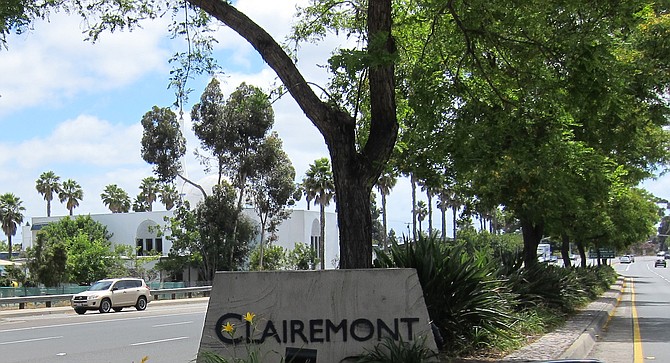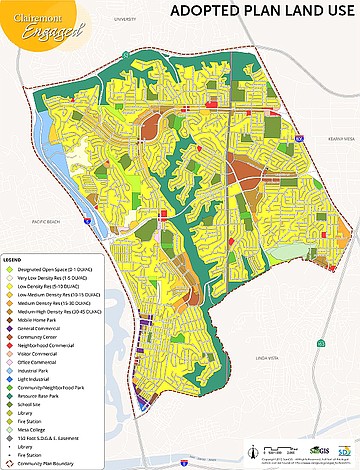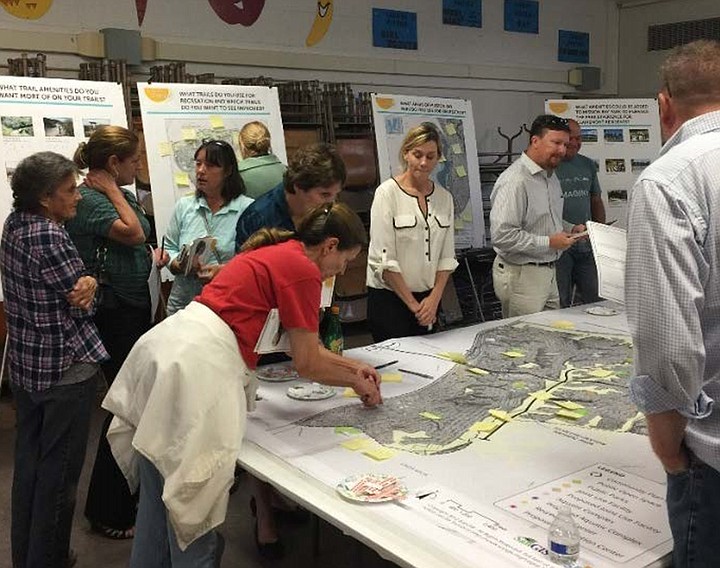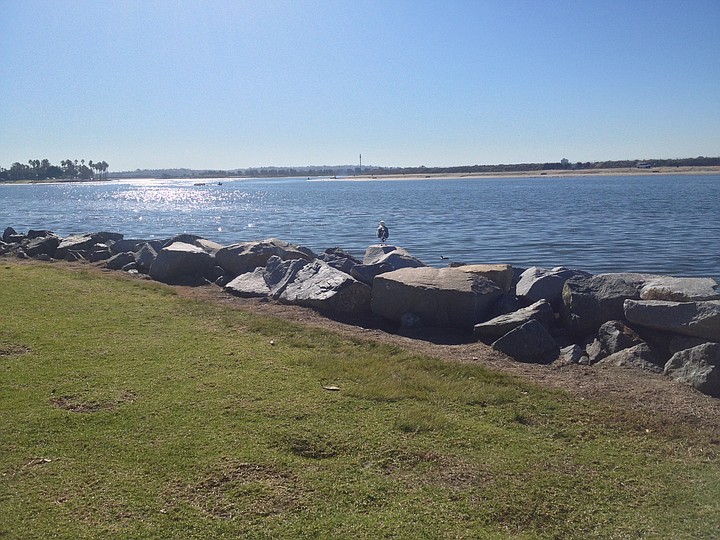 Facebook
Facebook
 X
X
 Instagram
Instagram
 TikTok
TikTok
 Youtube
Youtube

The update of the Clairemont community plan is in full swing. How this plan shapes up will determine the future of Clairemont and Bay Park until at least 2040. Senior city planner Marlon Pangilinan gave a presentation at a June 8 workshop with the purpose of seeking direction from the planning commission as to growth and development opportunities. The community has a lot going on — working on a specific plan for the Morena Corridor (draft presented to the community on June 19) and planning efforts to support the Mid-Coast trolley extension.

Clairemont is a post-WWII suburban community centrally located within the city with easy access to other communities, including downtown, University City, and Pacific Beach. Unique features include an extensive canyon system and primarily single-family neighborhoods.
The plan was last updated in 1989 when Maureen O'Conner was mayor and Dead Poets Society was playing on the big screen. Because of the flood of newcomers expected in coming years, the planning commission emphasized how important it is to get it right. If everything goes according to plan, the update should be written in stone in 2020.

Pangilinan shared 2015 demographics showing Clairemont's population at more than 80,000, a median income of $73,685, and nearly 60 percent white residents. With the current housing stock at around 33,000 units, it's unclear what magic number of new units that Clairemont needs to hit.

Existing land use breaks down to 43 percent single-family residential, seven percent multi-family residential, 16 percent parks and recreation, three percent commercial, one percent industrial, and one percent vacant or undeveloped. The remainder belongs to public right-of-ways and institutions. The maps that Pangilinan showed brought home how rich Clairemont is in low-density single-family housing.

As far as zoning, a slide illustrated Clairemont's 30-foot height restriction with one itty-bitty area that can go as tall as 40 feet. Pangilinan emphasized, "And we heard a lot from the community about maintaining the 30-foot height limit, that's one of the comments that we always hear."
Even though Clairemont has 120 acres of public park space, the city's general plan stipulates it needs closer to 225 acres. The community has said they want more parks in Bay Park. This community has Mission Bay Park in its front yard — the largest aquatic park of its kind in the nation. The community wants more amenities in canyons such as new trails, kiosks, and distance markers. According to Pangilinan, one of the most pervasive comments from the community — besides keeping the 30-foot height limit in place — has been the building of a pedestrian/bicycle bridge to make crossing over to Mission Bay Park safer from Clairemont.
When Pangilinan displayed a map that slowly peeled back the layers of areas in Clairemont not up for grabs as far as development or added density — it left scant opportunities. The off-limit areas were designated for single-family housing, open-space canyons, public facilities, industrial areas, and others "that have met the plan density or exceed the plan density, as well as areas that are condominiums." What remained were multi-family residential areas along Clairemont Mesa Boulevard, Clairemont Drive, Balboa Avenue, Linda Vista Frontage Road, and areas in community commercial centers.
Planning Commissioner chair Stephen Haase questioned the wisdom of not including areas with existing condominiums as areas for possible redevelopment and added density. "This plan is 28 years old, so achieving density in a 28-year-old plan might not still get us where we need to go." Haase said he would not so quickly rule out single-family housing zones either.
There were five public speakers, the majority deeply involved in the Clairemont planning process and one climate action advocate concerned about the lack of climate action goals thus far in the process. Though it was clear from city documents that there have been discussions of climate change with the community.
A major concern from public speakers was about the land use and zoning being gutted from the Morena specific plan with plans to include it only in the community plan update. One speaker read from a petition that asked for land use to be returned to the Morena plan so that community and developers could have more certainty.
Granny flats were brought up as a possible solution to upping density. Granny flats are rentable companion units that homeowners can add on like a guest house. The planning commission voted in May to ease regulations on them. This is similar to what happened in Point Loma years ago when some single-family lots were rezoned to allow granny flats. This well-meaning change from yesteryear is what has led to some developers coming into Point Loma now and building four condominiums on one single-family lot. Another major concern included having improvements to the community be concurrent with any new development.
The commissioners touched no topic as forcefully as density and the 30-foot height limit. Commissioner James Whalen referred to the $1 billion federal grant for the trolley line extension, "if we don't densify that line, we'll never get any more money like that again from the federal government." More than one commissioner said they would like to see less parking surfaces and more mixed-use residential in shopping centers.
Commissioner Vicki Granowitz asked that the city educate the community better. She said that every community thinks they are taking all the density or affordable and low-income housing, but when the statistics are pulled, it's usually not close to the truth. She told city staff if they "back down from communities like Clairemont that can handle it, you're going to have a harder time getting it into any community. So I think that you guys sort of need to buck up." She gave city staff a comical thumbs-up.
When it came to the 30-foot height limit, all the planning commissioners present seemed to be on the same page when it came to certain areas needing to go higher. Chairman Haase said that density goals would not be met otherwise.
The Clairemont community plan update subcommittee gathered on June 13 to get a debrief of the June 8 workshop. The meeting was lightly attended but heavily on the side of not losing the mandate to keep it under 30 feet. Red balloon sightings are expected.


The update of the Clairemont community plan is in full swing. How this plan shapes up will determine the future of Clairemont and Bay Park until at least 2040. Senior city planner Marlon Pangilinan gave a presentation at a June 8 workshop with the purpose of seeking direction from the planning commission as to growth and development opportunities. The community has a lot going on — working on a specific plan for the Morena Corridor (draft presented to the community on June 19) and planning efforts to support the Mid-Coast trolley extension.

Clairemont is a post-WWII suburban community centrally located within the city with easy access to other communities, including downtown, University City, and Pacific Beach. Unique features include an extensive canyon system and primarily single-family neighborhoods.
The plan was last updated in 1989 when Maureen O'Conner was mayor and Dead Poets Society was playing on the big screen. Because of the flood of newcomers expected in coming years, the planning commission emphasized how important it is to get it right. If everything goes according to plan, the update should be written in stone in 2020.

Pangilinan shared 2015 demographics showing Clairemont's population at more than 80,000, a median income of $73,685, and nearly 60 percent white residents. With the current housing stock at around 33,000 units, it's unclear what magic number of new units that Clairemont needs to hit.

Existing land use breaks down to 43 percent single-family residential, seven percent multi-family residential, 16 percent parks and recreation, three percent commercial, one percent industrial, and one percent vacant or undeveloped. The remainder belongs to public right-of-ways and institutions. The maps that Pangilinan showed brought home how rich Clairemont is in low-density single-family housing.

As far as zoning, a slide illustrated Clairemont's 30-foot height restriction with one itty-bitty area that can go as tall as 40 feet. Pangilinan emphasized, "And we heard a lot from the community about maintaining the 30-foot height limit, that's one of the comments that we always hear."
Even though Clairemont has 120 acres of public park space, the city's general plan stipulates it needs closer to 225 acres. The community has said they want more parks in Bay Park. This community has Mission Bay Park in its front yard — the largest aquatic park of its kind in the nation. The community wants more amenities in canyons such as new trails, kiosks, and distance markers. According to Pangilinan, one of the most pervasive comments from the community — besides keeping the 30-foot height limit in place — has been the building of a pedestrian/bicycle bridge to make crossing over to Mission Bay Park safer from Clairemont.
When Pangilinan displayed a map that slowly peeled back the layers of areas in Clairemont not up for grabs as far as development or added density — it left scant opportunities. The off-limit areas were designated for single-family housing, open-space canyons, public facilities, industrial areas, and others "that have met the plan density or exceed the plan density, as well as areas that are condominiums." What remained were multi-family residential areas along Clairemont Mesa Boulevard, Clairemont Drive, Balboa Avenue, Linda Vista Frontage Road, and areas in community commercial centers.
Planning Commissioner chair Stephen Haase questioned the wisdom of not including areas with existing condominiums as areas for possible redevelopment and added density. "This plan is 28 years old, so achieving density in a 28-year-old plan might not still get us where we need to go." Haase said he would not so quickly rule out single-family housing zones either.
There were five public speakers, the majority deeply involved in the Clairemont planning process and one climate action advocate concerned about the lack of climate action goals thus far in the process. Though it was clear from city documents that there have been discussions of climate change with the community.
A major concern from public speakers was about the land use and zoning being gutted from the Morena specific plan with plans to include it only in the community plan update. One speaker read from a petition that asked for land use to be returned to the Morena plan so that community and developers could have more certainty.
Granny flats were brought up as a possible solution to upping density. Granny flats are rentable companion units that homeowners can add on like a guest house. The planning commission voted in May to ease regulations on them. This is similar to what happened in Point Loma years ago when some single-family lots were rezoned to allow granny flats. This well-meaning change from yesteryear is what has led to some developers coming into Point Loma now and building four condominiums on one single-family lot. Another major concern included having improvements to the community be concurrent with any new development.
The commissioners touched no topic as forcefully as density and the 30-foot height limit. Commissioner James Whalen referred to the $1 billion federal grant for the trolley line extension, "if we don't densify that line, we'll never get any more money like that again from the federal government." More than one commissioner said they would like to see less parking surfaces and more mixed-use residential in shopping centers.
Commissioner Vicki Granowitz asked that the city educate the community better. She said that every community thinks they are taking all the density or affordable and low-income housing, but when the statistics are pulled, it's usually not close to the truth. She told city staff if they "back down from communities like Clairemont that can handle it, you're going to have a harder time getting it into any community. So I think that you guys sort of need to buck up." She gave city staff a comical thumbs-up.
When it came to the 30-foot height limit, all the planning commissioners present seemed to be on the same page when it came to certain areas needing to go higher. Chairman Haase said that density goals would not be met otherwise.
The Clairemont community plan update subcommittee gathered on June 13 to get a debrief of the June 8 workshop. The meeting was lightly attended but heavily on the side of not losing the mandate to keep it under 30 feet. Red balloon sightings are expected.
Comments